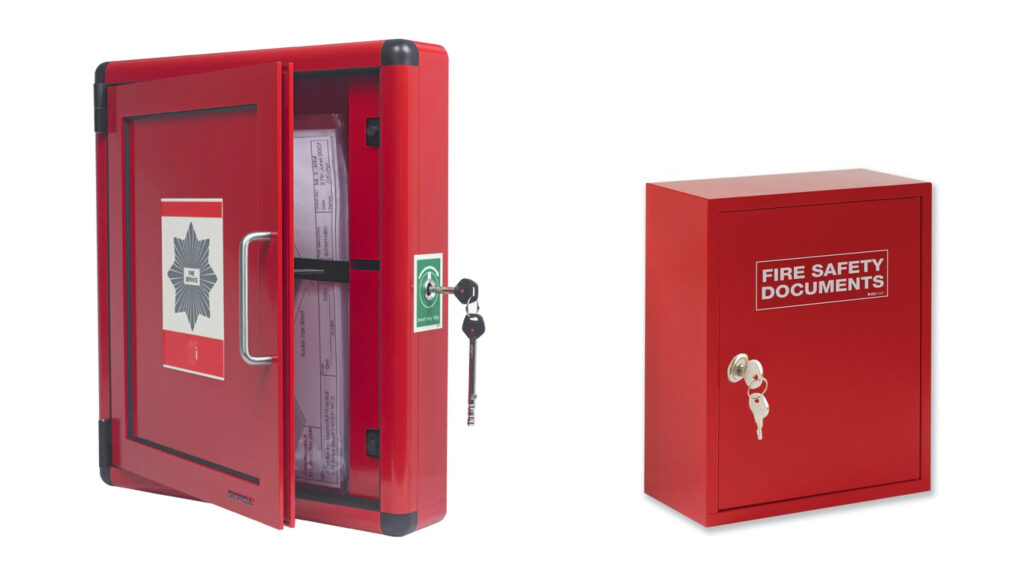There has been much confusion in the fire safety industry on where and how to store fire safety information. With new regulations and technology introduced in recent times, we’re writing this blog to help you understand and differentiate between what you must do and are recommended to do.
The first clarifications required are definitions – here are some terms you might hear from risk assessors and referenced online:
Secure Information Box (SIB): This is a term found in The Fire Safety (England) Regulations 2022. It serves as an easily identifiable repository for Emergency Documents intended for use by the fire and rescue service during a fire. It is only a legal requirement for certain residential buildings (In-Scope) which we will explain below.
Premises Information Box (PIB): This is a branded product from manufacturer Gerda. It is a popular product used to satisfy the requirement of a Secure Information Box. Its widespread use and advertising have led some people to confuse the product name with the official regulatory terminology (which does not specify the use of any manufacturer or product).

Document Holder: This is typically a non-fireproof, sheet metal box or vinyl wallet used for storing non-emergency fire safety documents on-site.
Fire Safety Documents: There are two types of fire safety documents emergency and non-emergency.
Emergency Documents: A specific set of documents outlined in The Fire Safety (England) Regulations 2022 required by the fire and rescue service during an emergency.
Non-Emergency Documents: Non-emergency documents are fire safety paperwork such as due diligence documentation e.g. fire logbook, maintenance certificates, fire risk assessments.
Am I required to install an SIB?
Your building is In-Scope and must install a Secure Information Box if any of the following apply:
- Existing Residential building (flats) over 18m in height
- New Residential building (flats) over 11m in height
- Residential building (flats) with a complicated layout regardless of height
- Student accommodation that is designed like flats regardless of height
- Student accommodation that is 11m or more in height
If none of the above apply, you are out-of-scope and do not need to install an SIB and can store all your Fire Safety Documents anywhere reasonable, including online.
If any of the above apply, you must install an SIB and read the next section.
Am I required to install a red metal document box?
Regardless of whether you require an SIB, there is no requirement to install a document box. The only requirement is that your Non-Emergency Documents are available and accessible to all interested parties (BS5839-1:2017 48.2).
This requirement means you are not allowed to hide or lock away your documents in a place where staff, contractors, or risk assessor cannot readily access to review/update – such as an SIB.
Storage alternatives include a Digital Fire Records software. These are one of the only solutions to guarantee the safety and security of Fire Safety Documents while maintaining accessibility.
This is done by uploading documents to an online portal and provide access via a hyperlink or QR code stuck to your Fire Alarm Control Panel. The most popular portal is Tio which is free for most use cases.
What am I required to store inside my SIB?
If you need one, you must store your Emergency Documents inside your SIB.
Emergency Documents are a specific set of documents outlined in The Fire Safety (England) Regulations 2022 required by the fire and rescue service during an emergency. They are:
- The Responsible Person’s UK contact details
- The UK contact details of any other person who has the facilities to and is permitted to access the building as the responsible person considers appropriate
- copies of the building’s floor plans – which identify specified key fire-fighting equipment
- a single page block plan – which identifies specified key fire-fighting equipment
Why non-emergency documents shouldn’t go in a SIB
Any non-emergency documents are recommended to be stored elsewhere, not inside your SIB. These are the reasons why:
- The purpose of the SIB is to store Emergency Documents that are useful to the fire rescue service during an emergency
- Non-emergency documents are a distraction during an emergency and may delay the fire and rescue service from locating the correct Emergency Documents
- Emergency documents should only be accessible during an emergency by the fire and rescue service. Co-locating non-emergency documents with emergency documents compromises the security of your Secure Information Box because unauthorized individuals such as contractors and staff will have regular access.
Summary: What Are Emergency Documents?
| Document | Emergency Docs | Non-Emergency Docs |
| Fire Risk Assessment | X | |
| Fire Logbook | X | |
| PPM Schedule | X | |
| Asset Register | X | |
| Certificates | X | |
| Responsible Person Details | X | |
| Floor Plans | X | |
| Block Plan | X |
Summary: What Should In-Scope Buildings Do?
| Type | Secure Information Box | Elsewhere |
| Emergency Docs | X | |
| Non-Emergency Docs | X |
Summary: What Should Out-of-Scope Buildings Do?
| Type | Secure Information Box | Elsewhere |
| Emergency Docs | X | |
| Non-Emergency Docs | X |
The Bottom Line
Misunderstanding whether you need a secure information box can end up costing your business thousands of pounds in purchasing and installing boxes you don’t need. If you need any further help on this, our team is available via live chat.